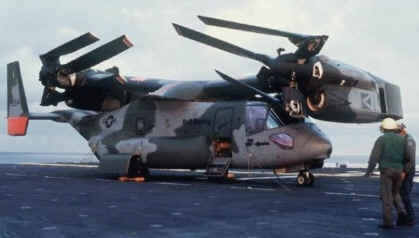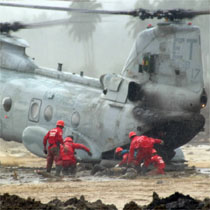G2mil's March article, V-22 Alternatives describes why V-22s are not shipboard compatible. This has been known by those profiting from the V-22 program for a decade. This is why they avoided deploying V-22s with naval task forces. However, all the CH-46Es have been retired from the East Coast, so V-22s were forced to deploy last month with the 22nd MEU. They deployed only 10, rather than the standard 12 with the CH-46E, because V-22s are twice their size.
Meanwhile, Marine Generals struggle to explain the dozens of missing V-22s to a congressional committee. In March 2009, the Marine Corps announced that all 73 of its MV-22s were grounded for inspection after several aircraft were found with loose bolts. However, Congress has funded 150 V-22s for the Marines through FY2009 (not including CV-22s for the Air Force) plus another 6 V-22s as part of supplemental funding. Around a dozen V-22s used in development have been retired or crashed, and only half of the 30 V-22s funded for FY2009 were delivered as of March. This leaves four dozen V-22s missing, and that's a big gap to explain away.
There are no longer V-22s in Iraq as the 12 based there have returned home - by ship. As the 8000-man 2nd Marine Brigade deploys to Afghanistan this month, none of the Corps' 140+ new MV-22s will go. The Corps was forced to mobilize a reserve squadron with 25-year old CH-53E helicopters to support them. It also spent millions of dollars to re-engine a squadron of 40-year old CH-53Ds to support that deployment, helicopters that were scheduled to be scrapped in 2006.
V-22 Maintenance on Ship
 The photo at
right shows Marines
performing engine maintenance on a CH-46E in the hangar deck below ship. Unlike helicopters with blades folded, a V-22 must be
unfolded to work on its engines. During evaluations, it was demonstrated that a V-22
can unfold in
the center of the hangar deck of an LHA/LHD -- big flattop amphibious
ship. However, there is clearance for just one V-22 to unfold, and this blocks the movement of
other aircraft
within the hangar.
The photo at
right shows Marines
performing engine maintenance on a CH-46E in the hangar deck below ship. Unlike helicopters with blades folded, a V-22 must be
unfolded to work on its engines. During evaluations, it was demonstrated that a V-22
can unfold in
the center of the hangar deck of an LHA/LHD -- big flattop amphibious
ship. However, there is clearance for just one V-22 to unfold, and this blocks the movement of
other aircraft
within the hangar.
The only alternative is to perform maintenance topside. That restricts flight operations and subjects maintainers to the weather. There can be no work in very cold weather, rain, or high winds, and maintainers must haul all their equipment and parts topside. Working at night is possible, but only if the tactical situation permits the ship to light up like a Christmas tree.
 Even in good weather a ship rocks and rolls at
sea, minor wind gusts are common, and downwash from other aircraft create gusts. A recent picture of Marines
servicing a V-22 at an
airstrip shows the problem. (left) Performing maintenance on a ladder is
dangerous on rocking ship,
so another maintainer must hold the ladder, effectively doubling the manpower
required for each task. In addition, the Marine performing a task is still
buffeted by wind gusts and a rocking boat.
Even in good weather a ship rocks and rolls at
sea, minor wind gusts are common, and downwash from other aircraft create gusts. A recent picture of Marines
servicing a V-22 at an
airstrip shows the problem. (left) Performing maintenance on a ladder is
dangerous on rocking ship,
so another maintainer must hold the ladder, effectively doubling the manpower
required for each task. In addition, the Marine performing a task is still
buffeted by wind gusts and a rocking boat.
Keep in mind that much of a maintainers time is spent unscrewing small screws, fasteners, and bolts, and then screwing them back. This is frustrating when a ship rocks and rolls while winds push him around, while he worries about falling off the ladder since there is little grab hold of. Finally, V-22s leak so much oil that a Marine must scamper up a ladder after each flight to refill. This is an extreme limitation since V-22s parked on deck landing spots are so large that the left engine hangs off the side of the deck.
The V-22 design makes this even worse. It has a heavy engine at each wingtip, so as a ship at sea routinely rocks and rolls, a V-22 see-saws side-to-side, causing the engines to move up and down a few inches. In short, V-22s are not compatible for shipboard deployments. They can land on ships to refuel and pick up and deliver personnel and cargo, but maintenance is impractical. These problems were identified by Marines in the 2003 Safety Survey after OT-IIE. There are no solutions, so the results of this survey were hidden from Pentagon leaders by a Bell-Boeing mole in DOT&E.
Twisting the Osprey
V-22s can pivot their wings for storage on ship. This has not been necessary at airbases, but during a typical 6-month shipboard deployment this may be required a hundred times. Each fold imparts stress on the V-22's lightweight titanium hydraulic lines. These become brittle below 50F and may crack. This may be why VMM-266 had trouble in November of last year as it trained on ship as part of the 26th MEU. A CH-46E squadron deployed in its place.
As a result, folding up V-22s has been avoided ashore. The extent of this problem is unknown, but it would cost nothing to test. On a cool morning, have a V-22 fold up and unfold 100 times in a row, then start her up and see what happens. That simple test alone could doom the V-22 program.
 According
to the Osprey community newsletter "Osprey
Nation", hydraulic leaks have caused engine fires that ruined three V-22s
thus far. Since the V-22's hydraulic lines run along each wing and within the
engine nacelles, they are stressed whenever the tiltrotor tilts, whenever the flexible
wings flex, whenever the rotors are up and pummel the wings causing extreme
vibration, and whenever the V-22 folds and unfolds.
According
to the Osprey community newsletter "Osprey
Nation", hydraulic leaks have caused engine fires that ruined three V-22s
thus far. Since the V-22's hydraulic lines run along each wing and within the
engine nacelles, they are stressed whenever the tiltrotor tilts, whenever the flexible
wings flex, whenever the rotors are up and pummel the wings causing extreme
vibration, and whenever the V-22 folds and unfolds.
A conference was recently held on possible solutions. Routing the hydraulic lines outside the engine nacelle was debated. This would prevent fires and allow easy inspection, but would expose them to damage from objects whipped up by the V-22's intense downwash. Engineers preferred the second option of using electric motors. It would take years to develop and test an electrical system, and V-22 production would end before that became available.
The V-22 is Fragile
The V-22 was canceled in 1992 after DoD engineers concluded that the tiltrotor concept is flawed. It is possible to build an airplane whose engines can tilt to take-off and land like a helicopter, but the compromise design is so heavy and inefficient that very little payload can be carried. In 1992, Navy Secretary Sean OíKeefe told the House Armed Services Committee: "The V-22 cannot be built to meet the requirements specified. Itís an engineering impossibility."
After the V-22 was resurrected for political reasons, Bell-Boeing engineers went to work to shed weight. The nose gun and NBC protection system were dropped. The strong kevlar flooring was removed. The fuselage was made 25% smaller than the CH-46E, even though it was expected to carry even more Marines. Components were left off until after test evaluations, like the hoist, deicers, and anti-missile flares. One crewman was deleted. These have been added back recently so payload was cut in half. The V-22 is now several thousand pounds above the "guaranteed empty weight" specified in its contract.
The V-22 was designed with many more composite parts that any other aircraft in the U.S. military. According to a 2005 Rand study these parts are lighter, but they are far more expensive, more difficult to replace, and nearly impossible to repair. It is not uncommon for trucks or forklifts to bump into a transport aircraft and make a big hole. Bullets and other weapons easily punch holes into assault aircraft. With aluminum, a Marine simply patches it and pounds it into shape. This can't be done with composites because the skin provides some of the fuselage strength. The new big Airbus jetliner has a composite upper body, but uses heavier aluminum for the lower body because they worry that a minor ramp accident could cause millions of dollars in damage to a composite section and require depot-level work to repair.
The V-22's fuel tanks, fuselage, and passenger seats were so light that they failed testing. New heavier fuel tanks and seats have since been added. However, the fuselage is too fragile and does not meet Navy crash standards unless it lands on a runway like an airplane so it can shed its engines before impact. This fuselage has proven fragile, which is one reason dozens of fairly new V-22s have been retired, although they are officially listed as "preserved." A 1995 Boeing press release explained how it improved performance of the original V-22A by shedding weight:
"This fuselage incorporates the lessons we learned in the Osprey's full-scale-development (FSD) phase, as well as some truly significant advances in manufacturing technology. As a result it is 1,541 pounds lighter and $2.07 million (29 percent) less expensive than the earlier FSD design. "The extensive use of automation, Integrated Product Teams and Advanced Technology Assembly system have produced a high-quality, high-precision product and we are seeing outstanding first-time fit and finish to extremely close tolerances." An example of the precision fit of the Osprey's parts is the final alignment of the fuselage sections. V-22 engineers have determined the sections will fit together to a tolerance of .010-inch -- equivalent to the thickness of a matchbook cover."
The problem is that 1,541 pounds shaved off the original V-22 design weakened the aircraft. After a couple years of service, the lightweight composite body and parts begin to fail. Repairs become too frequent or impossible because of cracks or parts that don't fit after hours of stress and vibration cause minor deformations. As a result, the aircraft is pushed into a hangar and unofficially retired. Proper mishap reports are never filed, and the aircraft is secretly hidden in a hangar. Damage of more that $1 million dollars requires a Class A mishap report and an independent JAG investigation. Nevertheless, no reports were filed as dozens of nearly new V-22's were damaged beyond repair.
Half the Performance for Twice the Cost
The misguided effort to procure more V-22s becomes absurd when one looks at the FY2010 budget request. The Marines want 30 more V-22s at a unit cost of $78 million each, even though the much celebrated five-year contract signed in 2008 guaranteed a price of $62 million for each V-22.
In comparison, the Navy wants 18 MH-60S Knighthawk helicopters at a unit cost of $28 million each. This proven helicopter can lift nearly as much as the V-22 even though its half its size. It can fire machine guns from its side doors and fire Hellfire missiles. The Army request for CH-47F helicopters has a unit of price of just $26 million each. That helicopter is smaller than the V-22 but has greater range and can lift twice as much and carry twice the number of troops. Boeing has produced a navalized variant, the CH-47E, in recent years that has folding rotors and saltwater resistant components.
The Army's C-27J STOL aircraft is the same size as the V-22 and uses the same two engines, yet it costs just $38 million each, and can carry twice as much three times farther. The V-22 costs even more than the C-40, which is the military version of the Boeing 737 passenger jet.
Osprey Down - Grassfire Edition
 Blogger
Springbored
provides the best instant analysis of Navy/Marine Corps incidents. His account
of the May V-22 mishap highlights two other problems with the V-22. When its
engines are in the helicopter mode, its hot jet engine exhaust can ignite dry
brush. This has rarely happened as V-22 have been restricted to hard surfaces,
or an occasional landing on a bare or green, grassy LZ.
Blogger
Springbored
provides the best instant analysis of Navy/Marine Corps incidents. His account
of the May V-22 mishap highlights two other problems with the V-22. When its
engines are in the helicopter mode, its hot jet engine exhaust can ignite dry
brush. This has rarely happened as V-22 have been restricted to hard surfaces,
or an occasional landing on a bare or green, grassy LZ.
This incident sounds like a minor crash during a take-off attempt from a swampy area that was caused by tires stuck in mud. The V-22 is twice as heavy as the CH-46E (pictured), so it is much more likely to become stuck in mud at an LZ. A helicopter rescue crewman with many years of experience in Vietnam with the big, wheeled HH-53A said they learned it was best to conduct hover pick-ups to avoid this. If landing was required, a crewman would always jump out and test the soil, because getting stuck in hostile territory may be fatal. Igniting the LZ may also be fatal to Marine infantrymen.
V-22 Mission Capable Rates
The V-22's true mission capable rates these past few years have been kept secret, but a rate of 68% was once reported in Iraq. Keep in mind that the Marines positioned $100 million in spare parts in Iraq before the first V-22s arrived. They operated from a modern airbase in huge hangars and were supported by 16 Boeing civilian maintainers. Such "tech reps" have deployed overseas for decades, but usually just one per unit to offer advice and report problems. Those sent to Iraq outnumbered the deployed V-22s and helped Marines perform maintenance, and ready rates were still dismal.
This has been explained as problems with a "new" aircraft. Marine Corps Brig. Gen. James F. Amos once stated: "I think the V-22 probably is high maintenance at this point. I think -- but make sure you understand one thing. Any new airframe at this point or any new system is going to be high maintenance. And why would that be? Because first of all, there is the real lack of experience in maintaining this."
The General made that statement about the V-22's poor mission
capable rate in 2000, so its ridiculous to use the same excuse nine years later.
The V-22
first flew in 1989 and went into production in 1997; it is not new. The V-22 program is older than the C-17 program, and C-17s
have mission capable rates above
85% and none have been retired or
"preserved." Back in 2001, everyone thought that Brig.
Gen. Amos would be forced to retire after he was caught telling lies
about V-22 readiness and conspiring to hide V-22 failures from DoD
leaders. The Inspector General even seized his computer. Pentagon insider
Franklin "Chuck" Spinney" summarized:

General Amos was not forced to retire, but was rewarded with three more promotions and is now the #2 Marine - the Assistant Commandant. Lt. Gen. McCorkle later retired and earned easy money as a consultant for several V-22 contractors. The lesson learned for ambitious Marine officers is that telling lies to hide problems is not only tolerated, but rewarded. As Congressmen hold more hearings on the V-22 scandal, they must be skeptical of all information received through "official" channels. The last time Congress examined the V-22 program was in May 2002, after the V-22 was declared ready to resume flight tests after a 17-month stand down. At the "return to flight" ceremony, Marine Col. Dan Schultz, the V-22 program manager, assured everyone: "All of the things that were wrong with this airplane have been fixed."
Carlton Meyer editorG2mil@Gmail.com
©2009 www.G2mil.com